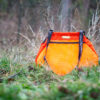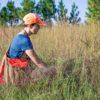Last summer, I spent a lot of time trying to teach Zara how to do a satisfactory duck search. Although she did do several good searches that would have been worthy of a NAVHDA Utility Prize 1, she was not consistent. And this showed on test day, when she was hesitant to enter the water and ultimately earned a score of 3, which led to a Prize 2.
This spring, I decided to test her one more time in Utility. Our test would be the first weekend of October. Duck search was the main thing I was concerned about, so that was my focus this summer. It finally paid off a few weeks ago when she got a 4 in duck search and a Utility Prize 1! There were multiple things I did differently this year that I believe contributed to her success.
More Opportunities
In the summer of 2020, I thought I gave Zara an adequate number of opportunities to practice duck searching. We did visit four different locations as well. But this summer, we did duck search a little more frequently. We trained about every two weeks from May until the end of September.
Laying Scent Trails
In April, I attended a NAVHDA duck search clinic that was sponsored by the Tarheel Chapter. Two NAVHDA judges visited and explained their method of teaching duck search using a “crawl, walk, run” philosophy. One of the techniques they used to lure dogs out into the water was to leave a scent trail starting close to the shore by dragging the live duck through the water and then releasing it further out. This was something I practiced with Zara the first few times we trained in early summer and it worked well. I probably should have done more of this, starting the scent trail further and further from shore, because she sometimes struggled when I moved to not having a scent trail.
Zara follows the scent trail that was laid by dragging the duck through the water. You can see the way she is sniffing the air with her nose. She is wearing her e-collar in this video, but that was the only time I used it for duck search this past summer.
Building Drive
One of the main things I needed to do with Zara was build her drive and desire to want to search for a live duck. While she has always had some level of desire to go out and search, she has never been one of those dogs who bounds into the swamp and is off like a shot, swimming into the far ranges of the water. I attribute this to a variety of things: genetics, her late exposure to duck search training, and the amount of obedience and encouragement to stay close I’d given her over the years.
For this part of the test, I wanted her to be amped up. So I did the following things:
Pulling on the Leash
Normally I don’t like her yanking me around while she’s on a leash. But every time I walked up to the send-off point of the duck search water, I let her drag me as much as she wanted. I put her in a quick “whoa” next to the bank and then sent her in. I knew in the test that heeling would not be evaluated prior to duck search.
No E-collar
This summer, I never put the e-collar on her while we were doing duck search training. While I’m not sure I had ever given her a correction while she was out searching or coming back, I know she is aware of when she’s wearing the e-collar and when she is not. Because she is somewhat more obedient while wearing the collar, I decided to go without it, just in case it helped her range further.
Made Her Wait
When I was training, I was typically with at least one or two people who were also running their dogs. On almost every occasion, I let their dog go first so that Zara would have to wait. Sometimes she could see partially see the other dog going to search. This made her annoyed, which I can verify because she would start trying to dig up her crate pad. I wanted her to get angry and ready to go.
Changed Commands
I originally used the command “fetch” to send Zara off on a duck search. It seemed logical because if she found the duck, I expected her to pick it up and bring it back to me. But this year I decided to change my command to “find it.” Technically I wasn’t asking her to just do a retrieve, I was asking her to go out and search. I had used the command “find it” somewhat in the past – mainly in the house when I would hide things for her to find, such as toys or treats, so I knew it had some meaning to her.
I used the command a few times on land at the beginning of the summer. I put out a few dead chukar or quail in a field and sent her off with a “find it” command. I stayed in one spot like you do for duck search. This worked pretty well, but once I was convinced that she understood what “find it” meant, I only used it during duck search to avoid any confusion.
Consistent Voice
Another thing I tried to improve on this summer was the tone of voice I used to give her the initial command. In the past, I have given her a firm command but it was not always stern enough. One of the NAVHDA friends I trained with really emphasized the importance of this. I am typically soft-spoken, so I had to make a conscious effort to raise my voice. I wanted her to understand that I meant business. I tried to be consistent every time and say it loudly and clearly.
In retrospect, I found “find it” a little hard to say in a loud voice. “Fetch” rolls off the tongue better. But it worked well enough.
Zara searches for the duck at least 50 yards from shore. It’s not the best video, but you can see her moving along. The friend who was helping me shot the duck so that is the gunshot sound you hear.
Don’t Let Her Play on the Bank
In the past, Zara has had the tendency to run the bank after I gave her the send command. She’s been hesitant to go out right away. Often I would just stand there, hoping she would go in. This year, I didn’t let that happen. If she didn’t initially go in the water, I would give her another command, or three or four, to make sure she knew that staying on the shore was not an option.
Always Do Resends
In the Utility Test, if the dog finds the duck quickly, the judges may ask you to resend your dog so that they can see if it has the desire to keep searching even after finding one duck. In training, it can be tempting to end the session after your dog has done a good search and found one duck. I didn’t always do resends in 2020 or 2019. But this year, I always had at least two live ducks and I resent her every single time.
Zara didn’t always want to go out again on the resend. This is where I had to keep giving her my firm commands, and sometimes she needed a little assistance from whoever was helping me, either in the form of a quack on the electronic launcher that held the duck, or by them calling her name.
On test day, she never found the duck, so I didn’t have to resend her. But I was prepared to if needed.
Always Make It Successful
In duck search training, I’ve learned that you always want your dog to be successful. In other words, you always want them to find a duck. This teaches them that searching pays off and there is always a duck out there when you send them. I was pretty good about this last year, but there were a few times that I sent Zara to search when she couldn’t find the duck, and I called her back without a reward. I never let that happen this summer. She found a duck on every single send and every single resend.
In order to make this happen, we taped the ducks to make it easier for her to grab them. I’ve found that she often has trouble getting the duck when only the flight feathers from one wing are pulled out (the way the duck is prepared during the Utility Test). In the few instances when the ducks got away, I made sure I had a spare dead duck that we could throw in her vicinity.
The only time she did not locate the duck this year was during the test. I do know she got close to it, because at one point I heard quacking.
Know Your Dog
While it’s great to have training rules to follow, you also have to know your dog and try to understand why they are doing certain behaviors. I knew that Zara can be a bit particular about the water. Sometimes she won’t go in if it’s too cold. This summer, we did a lot of training in a swamp that had a lot of lily pads. By August, the water was thick with lily pads which made it a little difficult for a dog to swim through. I trained there twice in a row and noticed that Zara was more hesitant to go out than she had been in the past. I also saw that after she finally got out there and got the duck, instead of swimming straight back to me, through all of the lily pads, she went all the way to the far side of the swamp where it was clear and came back that way.
This told me that she did not enjoy going through the lily pads. Since I didn’t want her to develop a negative association with duck search, I stopped training at that swamp. The good news was that the swamp where the test was held did not have many lily pads. We trained there a few times before the test and she had no issues swimming through that water.
Amp Up on Test Day
The day of the test, I knew I wanted Zara amped up before she had to go into the duck search water. After she’d completed the field work and duck drag, we had a little while to wait before it was her turn in the swamp. I talked her during this time, and asked her if she wanted to “get a duckie.” Yes, it’s silly, but I had used that phrase frequently over the summer when she was around ducks and about to search. I was trying to get her her prepared and ready to go. Then I let her pull me across the field toward the swamp.
Have you changed any training techniques to help your dog be more successful at duck search? Let me know in the comments.






